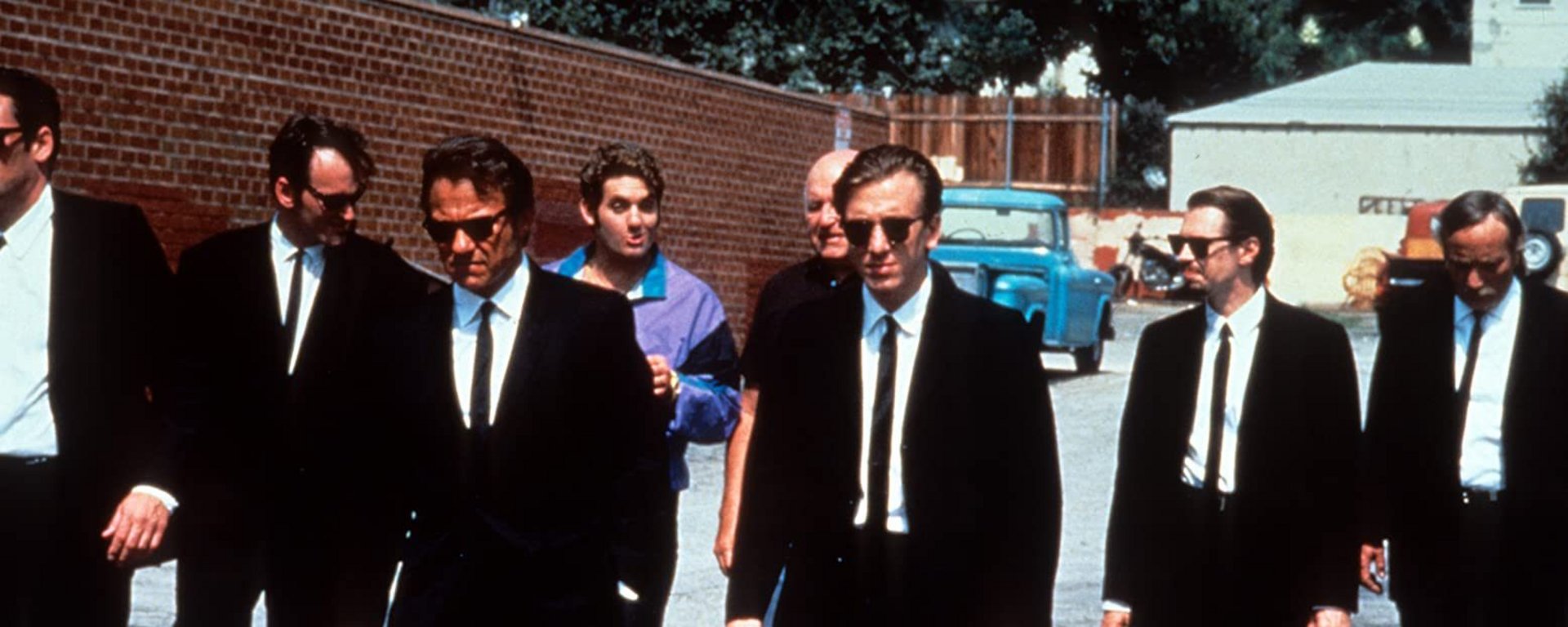
Reservoir Dogs
Quentin Tarantino’s debut feature was originally submitted for film classification in June 1992. It arrived with considerable notice, through its reception at various film festivals, of its blending of ‘cool’ style, pop culture references, and strong, bloody violence. The story of thieves falling out after a botched robbery contained elements of violence, criminal behaviour and extensive strong language that would anticipate the film’s classification at the most restrictive cinema category, 18.
Although strong, much of the generalised violence in the film, such as that which occurs during the robbery, happens off-screen or is limited to the climactic shootout at the warehouse and the strength of such ‘gangster’-related violence had been precedented in films such as Goodfellas.
The scenes of violence, combined with the bloody injury detail on show (notably that of Tim Roth’s badly wounded Mr Orange), made the classification of the film at 18 almost a formality. But even at that category the notorious sequence in which Michael Madsen’s Mr Blonde tortures a policeman by slicing off his ear, dousing him with petrol and threatening to set him on fire, was considered troubling in terms of its acceptability and was the subject of considerable debate within the BBFC.
Views were expressed that its gruesome and sadistic nature would cause some people to walk out of the film. It was also noted that Mr Blonde’s evident enjoyment of what he is doing ("It amuses me to torture a cop") as he dances around the helpless victim to the strains of 'Stuck In The Middle With You' coming from the radio, glamorised the sadism.
However, the general opinion was that the scene, whilst generating a sustained, intense and disquieting atmosphere of threat and menace, was remarkably restrained in what it actually showed. Apart from an initial indistinct slash to the policeman’s face with the razor, the audience does not see the detail of the ear being cut off as the camera moves away from the action, whilst the horror is suggested only by the sounds of the victim’s cries of pain. There is subsequent sight of the policeman’s mutilated face before the threat escalates as Mr Blonde pours petrol over him and lights a match – only to be shot dead by Mr Orange.
It was felt that the scene carried several mitigating factors that precluded further intervention at the adult category. These factors were: the lack of process in the violence that undercuts what BBFC Guidelines describe explicitly (and what would have been given significant weight in 1992) as ‘dwelling on the infliction of pain and injury’;
• its contextualisation as a crucial plot point that reveals Mr Orange as the undercover policeman whose identity Mr Blonde had been trying to extract from the torture victim;
• its playing on the film’s themes of loyalty and betrayal;
• and the clear establishment of Mr Blonde’s character as an unpleasant, sadistic psychopath with whom a viewer is not invited to identify or to glamorise.
Consequently, the film was passed at 18, without cuts, and went on to enjoy box office success in UK cinemas as Tarantino continued to garner critical acclaim, including some from parts of the UK press better known for their more censorious attitudes towards violence in films.
The work was next submitted in 1993 for its home video classification, but the video release would be delayed until 1995 because of the introduction of the Criminal Justice and Public Order Bill in 1993 and its lengthy passage through Parliament. In response to concerns about the effects of media violence, largely in the wake of the James Bulger murder in 1993, part of the Bill’s remit was to make amendments to the Video Recordings Act 1984 (VRA), under which the BBFC had been appointed as the statutory regulatory body for video.
The BBFC’s then director, James Ferman, played an active role in the drafting of this aspect of the Bill which clearly had implications for the video classification of works such as Reservoir Dogs. This is because, on its passing into law in 1994, it established within the VRA a specific ‘harm’ test. This ‘harm’ test required the BBFC to pay ‘special regard (among the other relevant factors) to any harm that may be caused to potential viewers or, through their behaviour, to society by the manner in which the work deals with [such issues as] criminal behaviour [and] violent behaviour and incidents’.
The criminal themes and violence (most notably the torture sequence) in Reservoir Dogs had therefore to be revisited in the light of potentially harmful effects – particularly to younger viewers – in the home viewing environment. In fact, the BBFC concluded that these issues could be robustly defended at 18.
The prolonged passage of time since the film release, during which Reservoir Dogs had achieved a wide recognition, meant that the public could not be ignorant of its content. Also the awareness of the kind of material present in a Quentin Tarantino film had been reinforced with the release of Pulp Fiction in 1994. Additionally, it had become clear through critical reaction to Reservoir Dogs that the film was as concerned with clever characterisation and dialogue as it was with violence, and did not have the intrinsic appeal to younger teenagers of more formulaic, mainstream action films.
Reservoir Dogs was finally granted an uncut 18 video certificate in May 1995, a considerable time after its video release in all the other major international markets, which did not prove too disconcerting for Tarantino who was reported to be delighted that the delay had given the film an extended theatrical life in the UK.
In 2006 a videogame based on the film was submitted to the BBFC and also passed at 18.